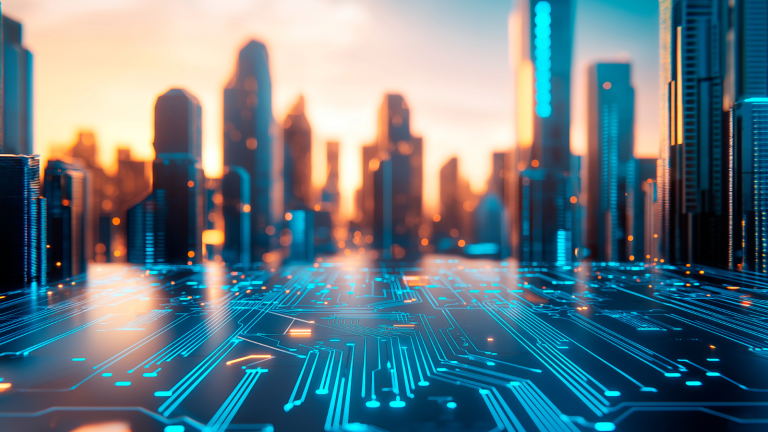Back in 1939, physicists Albert Einstein and Leo Szilard warned President Franklin D. Roosevelt that Nazi Germany might be on the verge of developing an atomic bomb.
That warning launched the original Manhattan Project. It was one of history’s most ambitious government–industry collaborations, mobilizing America’s greatest minds and vast resources to build the first nuclear weapon.
Today, something eerily similar is happening – only now, instead of splitting atoms, the mission is to unleash intelligence itself.
Last week, the Department of Energy (DOE) issued a formal request for proposals (RFP) to develop AI data centers and energy-generation infrastructure on the grounds of Oak Ridge National Laboratory in Tennessee.
Washington is moving quickly to stay ahead of this powerful megatrend.
Just like in 1942, government and industry are joining forces once again – this time, to build the world’s most powerful thinking machines.
And now, after that RFP, it looks like a chunk of that new project will be built on the grounds of Oak Ridge National Laboratory – home to several crucial original Manhattan Project facilities.
Federal action – from the $500 billion Stargate project announced in January to the federal government acquiring equity stakes in companies involved in rare earth minerals vital for artificial intelligence (AI) – is unleashing an unprecedented wave of private investment as well.
The world’s largest, most powerful companies are pouring hundreds of billions of dollars per year into this space to cement their AI leadership. Take a look at just a few recent developments:
- Analysts expect Meta (META) will spend $40 billion to $45 billion in capital expenditures (capex) this year, with AI infrastructure being the biggest driver.
- Microsoft‘s (MSFT) annual capex has nearly doubled since the pandemic, topping $50 billion, and guidance suggests it could push higher as AI cloud demand accelerates.
- Alphabet (GOOGL) has boosted annual spending from roughly $25 billion in 2021 to more than $50 billion in 2025, with a majority directed at AI compute and data centers.
- Consensus estimates peg Amazon‘s (AMZN) AWS-related capex above $70 billion this year.
This spending boom is massive.
And according to Bank of America‘s (BAC) latest numbers, it’s only getting bigger – and so are the investment opportunities.
Let’s take a look at some of those…
AI Infrastructure Spending Set to Hit $1 Trillion by 2028
Once in a generation, Wall Street is gifted a megatrend so massive, undeniable, and lucrative that investors simply cannot afford to sit on the sidelines.
The Industrial Revolution, electrification, the automobile, computing, the internet and mobile booms…
And now artificial intelligence – a technological force so powerful it’s sparking what we’re calling “The New Manhattan Project.”
In 2022, the global data center market was valued at about $275 billion. By 2024, it reached $406 billion. Here in 2025, it’s cracked $506 billion.
That is almost 2X growth in three years…
But that’s just the start. Fast forward to 2028, when total AI infrastructure spending is expected to hit nearly $940 billion… up nearly another 2X in three years to almost a trillion dollars.

The Department of Energy’s Oak Ridge initiative marks the first time a federal agency has explicitly tied national lab resources to commercial AI computing. The plan calls for new AI-optimized data centers and on-site power generation, signaling that the AI buildout is becoming strategic infrastructure at the national level.
To put that in context, the entire U.S. Interstate Highway System – one of the greatest infrastructure projects in our history – cost about half a trillion dollars in today’s money and took 35 years to build.
AI infrastructure will double that spend in less than half the time, making it the largest concentrated infrastructure buildout in history. And unlike roads or bridges, it’s being driven by a handful of hyperscalers – Microsoft, Amazon, Google, Meta, Tesla (TSLA) – all racing against each other in the biggest technological arms race we’ve ever seen.
Why the AI Capex Boom Is Just Getting Started
This “AI Bazooka” in spending isn’t losing steam. It’s reloading and firing faster.
Why?
- Scaling. Every new AI model requires 10- to 100x more compute than the last. The pace of AI demand now far exceeds the historical efficiency gains predicted by Moore’s Law; the principle that the speed and capability of computers can be expected to double every two years. As a result, hyperscalers are compensating with massive expansions in data center capacity, GPUs, cooling, and power.
The power challenge is already here. According to IEEE Spectrum, utilities are racing to add capacity as AI data-center loads strain national grids. Some facilities are even installing repurposed jet-engine turbines to generate on-site electricity. That’s how extreme the demand has become – and why the next frontier in AI infrastructure isn’t just chips but power itself. - Inference demand. Think of AI model training as the appetizer. The main course is inference – computing for billions of users, queries, robots, cars, and devices. That’s orders of magnitude more than training ever required.
- Geopolitics. The U.S., China, Middle East, and Europe are locked in an AI sovereignty race. No government will risk being left behind.
- New markets. Physical AI (robots, humanoids, AVs), AI PCs, edge devices, smart glasses – each new category demands more infrastructure on top of what’s already being built.
This is why the bazooka won’t stop firing. In fact, the deeper into the 2020s we go, the more violent the blast becomes.
The Winners Behind AI’s Massive Infrastructure Buildout
Everyone knows about Nvidia (NVDA), AMD (AMD), and the GPU titans. But the truth is the bazooka blast is much wider.
A data center is a living ecosystem, not just racks of GPUs. It involves:
- Power distribution – Schneider Electric, ABB, Eaton (ETN), Siemens, Vertiv (VRT)
- Backup generators – Generac (GNRC), Caterpillar (CAT), Rolls Royce, EnerSys (ENS)
- Cooling systems – Vertiv, Trane (TT), Carrier (CARR), Modine (MOD), Munters, Asetek
- Server cabinets & racks – Supermicro (SMCI), Dell (DELL), Hewlett Packard (HPE), IBM (IBM), Legrand
- Automation & monitoring – Schneider, Cisco (CSCO), ABB, Legrand
- Security & fire protection – Cisco, Fortinet (FTNT), Palo Alto (PANW), Siemens, Bosch

These are the companies in the AI Bazooka’s direct line of fire.
Every time Microsoft orders more GPUs, all of these companies benefit. Someone has to assemble the server cabinets, wire the electricity, cool the racks, provide the power, and secure the building.
In other words, this boom is not just Nvidia’s to win. It’s a rising tide lifting a whole constellation of infrastructure stocks.
BofA’s cost-per-megawatt breakdown tells the story. For every megawatt of IT capacity, $25 million flows to servers, $4.3 million juices networking, $1.9 million rolls into storage.
But then look at infrastructure:
- Switchgear, chillers, cooling towers, uninterruptible power supply (UPS) systems, generators, computer room air handlers (CRAHs), coolant distribution units (CDUs)… it adds up to another $4- to $5 million per megawatt.
That’s tens of billions of dollars of orders every year for industrials, utilities, and hardware specialists.
It means this isn’t just a “chip boom.” It’s an electrical boom, a cooling boom, a power boom.
The Largest Infrastructure Cycle in History, Driven by AI
The Interstate Highway System transformed mobility. The railroad boom transformed commerce. And the internet boom transformed communication.
Now the AI revolution is transforming intelligence itself – and doing so at a speed and scale that eclipses every prior infrastructure cycle.
It took half a century to lay the railroads. It may take just five years to build the foundations of the AI economy.
And the playbook is simple:
- Stay long the core enablers. Nvidia, AMD, Broadcom (AVGO), Supermicro – these are the companies literally supplying the AI brains and racks.
- Own the infrastructure multipliers. Vertiv (cooling & power), Schneider, ABB, Eaton (electrical backbones), Generac & Caterpillar (backup power), Carrier & Trane (HVAC), Fortinet & Palo Alto (security).
- Don’t fight the tape. As long as the AI bazooka is firing – and it is – dips in AI stocks are opportunities, not risks.
The AI Infrastructure Megatrend: How to Invest in the Next Supercycle
We are living through the fastest, largest, most capital-intensive infrastructure cycle the world has ever seen.
The New Manhattan Project is growing, and the companies in its “blast radius” will keep winning.
From Oak Ridge — where the first Manhattan Project once reshaped the 20th century — to every new data center rising today, history is repeating itself in silicon and steel.
That’s why the only mistake right now is not being invested.
As long as the New Manhattan Project continues, AI infrastructure stocks deserve a place in your portfolio.
But today’s AI bazooka isn’t just aimed at data centers…
It’s about to fire into humanoid robotics, with Tesla’s Optimus leading the charge. Morgan Stanley estimates this market could be worth trillions. But the biggest windfall won’t come from Tesla; it’ll come from the small, little-known suppliers making the actuators, sensors, and semiconductors that bring these machines to life.
If you want to be in front of the blast wave – not behind it – now’s the time to see which names are in the crosshairs.
Click here to see my full briefing before the AI Bazooka fires again.

